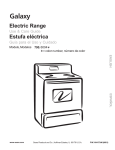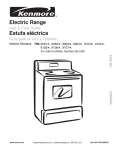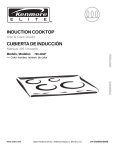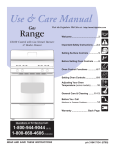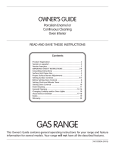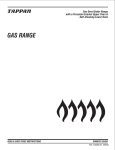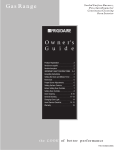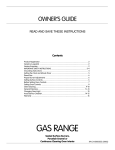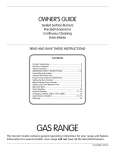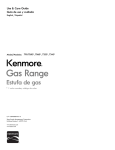Download Sears Galaxy 10655132701 Use & care guide
Transcript
Galaxy Gas Range Use & Care Guide Estufa de gas Guía para el Uso y Cuidado Models, Modelos 790. 6000¾, 6001¾ ¾= color number, número de color ENGLISH ESPAÑOL www.sears.com Sears Roebuck and Co., Hoffman Estates, IL 60179 U.S.A. P/N 316462419 (0605) Table of Contents Product Record Free-Standing Range Warranty ............................................ 2 Product Record ..................................................................2 Serial Plate Location .......................................................... 2 IMPORTANT SAFETY INSTRUCTIONS ....................... 3-5 Master Protection Agreements ..........................................6 Setting Surface Controls .................................................... 7 Before Setting Oven Controls ............................................8 Setting Oven Controls ......................................................... 9 General Care & Cleaning .............................................. 10-13 Before You Make a Service Call ................................... 14-15 Sears Service ..................................................... Back cover Español ........................................................................ 17-32 In this space below, record the date of purchase, model and serial number of your product. You will find the model and serial number printed on an identification plate. See the bottom of the page for the serial plate location. 790. Model No. _____________________________________ Serial No. _____________________________________ Date of Purchase ________________________________ Save these instructions and your sales receipt for future reference. Galaxy Appliance Warranty One Year Limited Warranty When installed, operated and maintained according to all instructions supplied with the product, if this appliance fails due to a defect in material or workmanship within one year from the date of purchase, call 1-800-4-MY-HOME ® to arrange for free repair. If this appliance is used for other than private family purposes, this warranty applies for only 90 days from the date of purchase. This warranty covers only defects in material and workmanship. Sears will NOT pay for: 1. Expendable items that can wear out from normal use, including but not limited to filters, belts, light bulbs, and bags. 2. A service technician to instruct the user in correct product installation, operation or maintenance. 3. A service technician to clean or maintain this product. 4. Damage to or failure of this product if it is not installed, operated or maintained according to all instructions supplied with the product. 5. Damage to or failure of this product resulting from accident, abuse, misuse or use for other than its intended purpose. 6. Damage to or failure of this product caused by the use of detergents, cleaners, chemicals or utensils other than those recommended in all instructions supplied with the product. 7. Damage to or failure of parts or systems resulting from unauthorized modifications made to this product. Disclaimer of implied warranties; limitation of remedies Customer’s sole and exclusive remedy under this limited warranty shall be product repair as provided herein. Implied warranties, including warranties of merchantability or fitness for a particular purpose, are limited to one year or the shortest period allowed by law. Sears shall not be liable for incidental or consequential damages. Some states and provinces do not allow the exclusion or limitation of incidental or consequential damages, or limitations on the duration of implied warranties of merchantability or fitness, so these exclusions or limitation may not apply to you. This warranty applies only while this appliance is used in the United States and Canada. This warranty gives you specific legal rights, and you may also have other rights which vary from state to state. Sears, Roebuck and Co., Dept. 817WA, Hoffman Estates, IL 60179 Sears Canada Inc., Toronto, Ontario, Canada M5B 2B8 Serial Plate Location You will find the model and serial number printed on the serial plate. Please refer to the illustration(s) shown at right to locate the serial plate on your range. Remember to record the serial number under Product Record on this page for future reference. 2 Important Safety Instructions Read all instructions before using this appliance. Save these instructions for future reference. This Use & Care guide contains important safety symbols and instructions. Please pay attention to these symbols and follow all instructions given. This symbol will help alert you to situations that may cause serious bodily harm, death or property damage. This symbol will help alert you to situations that may cause bodily injury or property damage. If the information in this manual is not followed exactly, a fire or explosion may result causing property damage, personal injury or death. • • • • To reduce the risk of tipping, the range must be secured by properly installed anti-tip bracket provided with the range. To check if the bracket is installed properly, grasp the top rear edge of the range and carefully attempt to tilt it forward. Refer to the Installation Instructions for proper anti-tip bracket installation. • Remove all tape and packaging before using the range. Destroy the carton and plastic bags after unpacking the range. Never allow children to play with packaging material. • Proper Installation—Be sure your appliance is properly installed and grounded by a qualified technician in accordance with the National Fuel Gas Code ANSI Z223.- latest edition, or in Canada CAN/CGA B149.1, and CAN/CGA B149.2, and the the National Electrical Code ANSI/NFPA No.70-latest edition, or in Canada CSA Standard C22.1, Canadian Electrical Code, Part 1, and local code requirements. Install only per installation instructions provided in the literature package for this range. Ask your dealer to recommend a qualified technician and an authorized repair service. Know how to disconnect the power to the range at the circuit breaker or fuse box in case of an emergency.• User Servicing—Do not repair or replace any part of the appliance unless specifically recommended in the manuals. To reduce the risk of personal injury and damage to the range, all other servicing should be done only by a qualified technician. • Never modify or alter the construction of a range by removing leveling legs, panels, wire covers, anti-tip brackets/screws, or any other part of the product. • Air curtain or other overhead range hoods, which operate by blowing a downward air flow on to a range, shall not be used in conjunction with gas ranges other than when the hood and range have been designed, tested and listed by an independent test laboratory for use in combination with each other. NEVER use this appliance as a space heater to heat or warm the room. Doing so may result in carbon monoxide poisoning. NEVER cover any slots, holes or passages in the oven bottom or cover an entire rack with materials such as aluminum foil. Doing so blocks air flow through the oven and may cause carbon monoxide poisoning. Aluminum foil linings may trap heat, causing a fire hazard. Do not use the oven or broiler drawer for storage. Do not store items of interest to children in the cabinets above a range or on the backguard of a range. Children climbing on the range to reach items could be seriously injured. • Storage in or on Appliance—Flammable materials should not be stored in an oven, near surface burners or in the broiler drawer. This includes paper, plastic and cloth items, such as cookbooks, plasticware and towels, as well as flammable liquids. Do not store explosives, such as aerosol cans, on or near the range. • Do Not Leave Children Alone—Children should not be left alone or unattended in the area where appliance is in use. They should never be allowed to sit or stand on any part of the appliance. Stepping, leaning or sitting on the doors or drawers of this range can result in serious injuries and also cause damage to the range. Do not allow children to climb or play around the range. The weight of a child on an open door may cause the range to tip, resulting in serious burns or other injury. 3 ENGLISH FOR YOUR SAFETY: — Do not store or use gasoline or other flammable vapors and liquids in the vicinity of this or any other appliance. — WHAT TO DO IF YOU SMELL GAS: • Do not try to light any appliance. • Do not touch any electrical switch; do not use any phone in your building. • Immediately call your gas supplier from a neighbor's phone. Follow the gas supplier's instructions. • If you cannot reach your gas supplier, call the fire department. — Installation and service must be performed by a qualified installer, servicer or the gas supplier. All ranges can tip. Injury to persons could result. Install anti-tip device packed with range. See Installation Instructions. Important Safety Instructions • DO NOT TOUCH SURFACE BURNERS, AREAS NEAR THESE BURNERS, OVEN BURNERS OR INTERIOR SURFACES OF THE OVEN. Both surface and oven burners may be hot even though flames are not visible. Areas near surface burners may become hot enough to cause burns. During and after use, do not touch, or let clothing or other flammable materials touch these areas until they have had sufficient time to cool. Among these areas are the cook top, surfaces facing the cook top, the oven vent openings and surfaces near these openings, oven door and window. • Wear Proper Apparel—Loose-fitting or hanging garments should never be worn while using the appliance. Do not let clothing or other flammable materials contact hot surfaces. • Do Not Use Water or Flour on Grease Fires—Smother the fire with a pan lid, or use baking soda, a dry chemical or foam-type extinguisher. • When heating fat or grease, watch it closely. Fat or grease may catch fire if allowed to become too hot. • Use Only Dry Potholders—Moist or damp potholders on hot surfaces may result in burns from steam. Do not let potholders touch hot heating elements. Do not use a towel or other bulky cloth instead of a potholder. • Do Not Heat Unopened Food Containers—Buildup of pressure may cause container to burst and result in injury. • Remove the oven door from any unused range if it is to be stored or discarded. burners. • Never Leave Surface Burners Unattended at High Heat Settings—Boilovers cause smoking and greasy spillovers that may ignite, or a pan that has boiled dry may melt. • Protective Liners—Do not use aluminum foil to line surface burner pans, or oven bottom, except as suggested in this manual. Improper installation of these liners may result in risk of electric shock, or fire. • Glazed Cooking Utensils—Only certain types of glass, glass/ ceramic, ceramic, earthenware, or other glazed utensils are suitable for cook top service without breaking due to the sudden change in temperature. Check the manufacturer’s recommendations for cook top use. • When flaming foods under a ventilating hood, turn the fan on. IMPORTANT INSTRUCTIONS FOR USING YOUR OVEN • Use Care When Opening Oven Door—Stand to the side of the range when opening the door of a hot oven. Let hot air or steam escape before you remove or replace food in the oven. • Keep Oven Vent Ducts Unobstructed. The oven vent is located below the backguard. Touching the surfaces in this area when the oven is operating may cause severe burns. Also, do not place plastic or heat-sensitive items on or near the oven vent. These items could melt or ignite. • Placement of Oven Racks. Always place oven racks in desired location while oven is cool. If rack must be moved while oven is hot use extreme caution. Use potholders and grasp the rack with both hands to reposition. Do not let potholders contact the hot heating elements in the oven. Remove all utensils from the rack before moving. • Do not use the broiler pan without its insert. The broiler pan and its insert allow dripping fat to drain and be kept away from the high heat of the broiler. • Do not cover the broiler insert with aluminum foil. Exposed fat and grease could ignite. IMPORTANT—ELECTRIC IGNITION MODELS ONLY: Do not attempt to operate the oven during a power failure. If the power fails, always turn off the oven. If the oven is not turned off and the power resumes, the oven will begin to operate again. Once the power resumes, reset the clock and oven function. IMPORTANT INSTRUCTIONS FOR USING YOUR COOKTOP Use Proper Flame Size—Adjust flame size so it does not extend beyond the edge of the utensil. The use of undersized utensils will expose a portion of the burner flame to direct contact and may result in ignition of clothing. Proper relationship of utensil to flame will also improve efficiency. • Know which knob controls each surface burner. Place a pan of food on the burner before turning it on, and turn the burner off before removing the pan. •Always turn knob to the full LITE position when igniting top burners. Visually check that burner has lit. Then adjust the flame so it does not extend beyond the edge of the utensil. • Utensil Handles Should Be Turned Inward and Not Extend Over Adjacent Surface Burners—To reduce the risk of burns, ignition of flammable materials, and spillage due to unintentional contact with the utensil, the handle of the utensil should be positioned so that it is turned inward, and does not extend over adjacent surface IMPORTANT INSTRUCTIONS FOR CLEANING YOUR RANGE • Clean the range regularly to keep all parts free of grease that could catch fire. Pay particular attention to the area underneath each surface element. Do not allow grease to accumulate. Refer to the range manufacturer’s instructions for cleaning. • Kitchen cleaners and aerosols—Always follow the manufacturer’s recommended directions for use. Be aware that excess residue from cleaners and aerosols may ignite causing damage and injury. 4 Important Safety Instructions GROUNDING INSTRUCTIONS (electric ignition models only) Avoid fire hazard or electrical shock. Do not use an adapter plug, an extension cord, or remove grounding prong from electrical power cord. Failure to follow this warning can cause serious injury, fire or death. This appliance is equipped with a 3-prong grounding plug for your protection against shock hazard and should be plugged directly into a properly grounded receptacle. DO NOT cut or remove the grounding prong from this plug. For personal safety, the range must be properly grounded. For maximum safety, the power cord must be plugged into an electrical outlet that is correctly polarized and properly grounded. See the INSTALLATION INSTRUCTIONS packaged with this range for complete installation and grounding instructions. IMPORTANT SAFETY NOTICE The California Safe Drinking Water and Toxic Enforcement Act requires the Governor of California to publish a list of substances known to the state to cause cancer, birth defects or other reproductive harm, and requires businesses to warn customers of potential exposure to such substances. 5 ENGLISH If a 2-prong wall receptacle is the only available outlet, it is the personal responsibility of the consumer to have it replaced with a properly grounded 3-prong wall receptacle installed by a qualified electrician. PROTECTION AGREEMENTS ACUERDOS DE PROTECCIÓN In the U.S.A. En los EE.UU. Master Protection Agreements Congratulations on making a smart purchase. Your new Kenmore® product is designed and manufactured for years of dependable operation. But like all products, it may require preventive maintenance or repair from time to time. That’s when having a Master Protection Agreement can save you money and aggravation. Acuerdos maestros de protección Lo felicitamos por haber hecho una compra inteligente. Su nuevo producto Kenmore® fue diseñado y fabricado para ofrecer muchos años de servicio confiable. Sin embargo, como todo producto, el mismo podría requerir mantenimiento preventivo o reparaciones ocasionales. Es por eso que el tener un Acuerdo maestro de protección podría ahorrarle dinero y molestias. Purchase a Master Protection Agreement now and protect yourself from unexpected hassle and expense. Adquiera ya un Acuerdo maestro de protección y protéjase de gastos y frustraciones inesperados. The Master Protection Agreement also helps extend the life of your new product. Here’s what’s included in the Agreement: 9 9 9 9 9 9 9 9 El Acuerdo maestro de protección también ayuda a extender la vida de su producto nuevo. El Acuerdo incluye lo siguiente: Expert service by our 12,000 professional repair specialists. Unlimited service and no charge for parts and labor on all covered repairs. “No-lemon” guarantee – replacement of your covered product if four or more product failures occur within twelve months. Product replacement if your covered product can’t be fixed. Annual Preventive Maintenance Check at your request – no extra charge. Fast help by phone – phone support from a Sears technician on products requiring in-home repair, plus convenient repair scheduling. Power surge protection against electrical damage due to power fluctuations. Rental reimbursement if repair of your covered product takes longer than promised. Once you purchase the Agreement, a simple phone call is all that it takes for you to schedule service. You can call anytime day or night, or schedule a service appointment online. 9 Servicio profesional por nuestros 12.000 profesionales especialistas en reparación. 9 Servicio ilimitado sin cargos adicionales por piezas y servicio en todas las reparaciones cubiertas. 9 Garantía de “no-limón” – reemplaza su producto cubierto si ocurren cuatro o más desperfectos en los primeros doce meses. 9 Reemplazo del producto si el mismo no puede ser reparado. 9 Verificación de mantenimiento preventivo anual a su petición y sin cargos adicionales. 9 Pronta ayuda por teléfono – apoyo por teléfono por un técnico de Sears en los productos que requieran reparación en casa, además de la conveniencia de hacer una cita para la reparación. 9 Protección contra picos de energía o daños eléctricos causados por fluctuaciones de la corriente eléctrica. 9 Reembolso del alquiler si la reparación de su producto cubierto toma más del tiempo prometido. Una vez que adquiera este Acuerdo, una simple llamada telefónica es todo lo que necesita para hacer una cita de servicio. Usted puede llamar a cualquier hora del día o de la noche para programar una cita de servicio por Internet. Sears has over 12,000 professional repair specialists, who have access to over 4.5 million quality parts and accessories. That’s the kind of professionalism you can count on to help prolong the life of your new purchase for years to come. Purchase your Master Protection Agreement today! Sears cuenta con más de 12.000 profesionales especialistas de reparación con acceso a más de 4,5 millones de piezas y accesorios de calidad. Esa es la clase de profesionalismo con la que puede contar para extender la vida útil de su nueva adquisición por muchos años. ¡Adquiera su Acuerdo maestro de protección hoy! Some limitations and exclusions apply. For prices and additional information call 1-800-827-6655. Algunas limitaciones y exclusiones podrían aplicarse. Para precios e información adicional, llame al 1-800-827-6655. Sears Installation Service For Sears professional installation of home appliances, garage door openers, water heaters, and other major home items, in the U.S.A. call 1-800-4-MY-HOME®. Servicio de instalación Sears Para una instalación profesional de Sears en electrodomésticos, abridores de puertas de garaje, calentadores de agua y otros artículos mayores del hogar, llame al 1-888-SU-HOGAR®. REV. 030509 6 Setting Surface Controls Always select cookware that is suitable for the amount and type of food being prepared. Select a burner and flame size appropriate to the pan. Never allow flames to extend beyond the outer edge of the pan. Each burner lights automatically from either an electric ignitor or standing pilot, depending on your model. Standing pilots must be lit initially. Refer to your installation instruction book for directions on lighting the standing pilot. Standing pilots will remain lit when the burners are turned off. Models with electric ignitors light automatically each time a control knob is turned to the LITE position. Operating the Surface Burners 1. Place cooking utensil on surface burner. 2. Push the surface control knob in and turn counterclockwise out of the OFF position. 3. Release the knob and rotate to the LITE position. If your range is equipped with electronic ignitors, all four ignitors will spark at the same time. However, only the burner you are turning on will ignite. 3. Visually check that the burner has lit. 4. Push the control knob in and turn counterclockwise to the desired flame size. The control knobs do not have to be set at a particular setting. Use the guides and adjust the flame as needed. DO NOT cook with the surface control knob in the LITE position. (The electronic ignitor will continue to spark if the knob is left in the LITE position.) Setting Proper Surface Burner Flame Size For most cooking, start on the highest control setting and then turn to a lower one to complete the process. Use the recommendations below as a guide for determining proper flame size for various types of cooking. The size and type of utensil used and the amount of food being cooked will influence the setting needed for cooking. For deep fat frying, use a thermometer and adjust the surface control knob accordingly. If the fat is too cool, the food will absorb the fat and be greasy. If the fat is too hot, the food will brown so quickly that the center will be undercooked. Do not attempt to deep fat fry too much food at once as the food will neither brown nor cook properly. Never extend the flame beyond the outer edge of the utensil. A higher flame simply wastes heat and energy, and increases your risk of being burned by the flame. *Flame Size High Flame Medium Flame Low Flame Type of Cooking Start most foods; bring water to a boil; pan broiling. Maintain a slow boil; thicken sauces, gravies; steaming. Keep foods cooking; poach; stewing. *These settings are based on using medium-weight metal or aluminum pans with lids. Settings may vary when using other types of pans. The color of the flame is the key to proper burner adjustment. A good flame is clear, blue and hardly visible in a well-lighted room. Each cone of flame should be steady and sharp. Adjust or clean burner if flame is yellow-orange. 7 ENGLISH Do not place plastic items such as salt and pepper shakers, spoon holders or plastic wrappings on top of the range when it is in use. These items could melt or ignite. Potholders, towels or wood spoons could catch fire if placed too close to a flame. ELECTRIC IGNITION MODELS ONLY In the event of an electrical power outage, the surface burners can be lit manually. To light a surface burner, hold a lit match to the burner head, then slowly turn the Surface Control knob to LITE. After burner lights push in and turn knob to desired setting. Use CAUTION when lighting surface burners manually. Before Setting Oven Controls Oven Vent Location The oven vent is located at the rear center of the cook top. When the oven is on, warm air is released through this vent. This venting is necessary for proper air circulation in the oven and good baking results. DO NOT BLOCK THE OVEN VENT. Arranging Oven Racks ALWAYS ARRANGE OVEN RACKS WHEN THE OVEN IS COOL (PRIOR TO OPERATING THE OVEN). Always use oven mitts when using the oven. Removing & Replacing Oven Racks To remove, pull the rack forward until it stops. Lift up front of rack and slide out. To replace, fit the rack onto the guides on the oven walls. Tilt the front of the rack upward and slide the rack back into place. Arranging Oven Racks with 6 Rack Positions To bake on a single rack, place the rack on position 3 or 4. To bake on 2 racks, place the racks on positions 3 and 5. 8 Setting Oven Controls Bake Note: The knob shown may not look identical to the knob on your range. The illustration is representational. 1. Arrange oven racks while the oven is still cool. See "Arranging Oven Racks" under Before Setting Oven Controls. 2. Push in and turn the Temperature Control knob to the desired temperature. 3. Preheat the oven for 10 to 12 minutes before baking. Preheating is not necessary when roasting, cooking casseroles or broiling most foods. 4. When cooking is finished, turn the Temperature Control knob to OFF. Broil Slide broiler drawer out to the stop position. Remove broiler pan and insert (See Fig. 1). Always position rack before setting control, while range is cool. Position rack by tilting front of rack up and pulling rack out from locating holes in rear of broiler drawer. Reposition back of rack in the desired locating holes and allow front of rack to slide down into the corresponding slots in front of broiler drawer (See Fig. 2). For rare meats, position the rack closer to the burner (upper position). For medium foods use middle position. For well-done foods such as chicken, lobster tails or thick cuts of meat, position the rack further from the burner (lower position). Fig. 1 5. Place insert on broiler pan, then place meat on insert. DO NOT use the broiler pan without the insert. DO NOT cover the insert with aluminum foil. The exposed fat could ignite. 6. Place broiler pan on rack; make sure the broiler pan and insert is positioned as shown, Fig. 1. Be sure front of pan is positioned correctly in rack. 7. Slide the broiler drawer all the way into the range. 8. Push in and turn the Temperature Control knob to BROIL. 9. Broil on one side until food is browned; turn and cook on the second side. Season and serve. ALWAYS pull the broiler drawer out to the stop position before turning or removing food. 10. When broiling is finished, turn the Temperature Control knob to OFF. 11. When removing broiler pan from broiler drawer always use pot holders. DO NOT use the broiler drawer for storage. Items placed in the broiler drawer will catch fire. Should a broil fire occur, leave the broiler drawer closed and turn the oven off. If the fire continues, throw baking soda on the fire or use a fire extinguisher. DO NOT put water or flour on the fire. Flour may be explosive. Fig. 2 9 ENGLISH 1. 2. 3. 4. General Care & Cleaning Follow these cleaning precautions: • Allow the oven to cool before cleaning. • Wear rubber gloves when cleaning the appliance manually. Ammonia must be rinsed before operating the oven. Provide adequate ventilation. DO NOT line the oven walls, bottom, racks or any other part of the appliance with aluminum foil. Doing so will destroy heat distribution, produce poor baking results and cause permanent damage to the oven interior (aluminum foil will melt to the interior surface of the oven). REMOVE SPILLOVERS AND HEAVY SOILING AS SOON AS POSSIBLE. REGULAR CLEANINGS WILL REDUCE THE EFFORT REQUIRED FOR MAJOR CLEANINGS LATER. Porcelain Enamel Oven and Broiler Drawer The oven interior is porcelain on steel, it is safe to clean using oven cleaners. General Cleaning Remove soils using hot, soapy water. Do not allow food spills with a high sugar or acid content (such as milk, tomatoes, saukerkraut, fruit juices or pie filling) to remain on the surface as they may cause a dull spot even after cleaning. To Remove Heavy Soil 1. Allow a dish of ammonia to sit in the oven overnight or for several hours with the oven door closed. Clean softened dirt spots using hot, soapy water. Rinse well with water and a clean cloth. 2. If soil remains, use a soap-filled scouring pad or a nonabrasive cleaner. If necessary, use an oven cleaner following manufacturer's instructions. DO NOT mix ammonia with other cleaners. 3. Clean any soil from the oven frame, the door liner outside the oven door gasket and the small area at the front center of the oven bottom. Clean with hot, soapy water. Rinse well using clean water and a cloth. Adhere to the following precautions when using oven cleaners: 1. DO NOT spray cleaner on the electrical controls or switches because it could cause a short circuit and result in sparking or fire. 2. DO NOT allow a film from the cleaner to build up on the temperature sensing bulb; it could cause the oven to heat improperly. (The bulb is located in the rear of the oven.) Carefully wipe the bulb clean after each oven cleaning, being careful not to move the bulb. A change in its position could affect how the oven bakes. Avoid bending the bulb and capillary tube. 3. DO NOT spray any cleaner on the oven door trim or gasket, broiler drawer glides, handles or any exterior surfaces of the range, plastic or painted surfaces. The cleaner can damage these surfaces. To Clean the Oven Bottom The oven bottom is porcelain enamel and can be removed for easier cleaning. Clean using hot, soapy water, a mild abrasive cleanser, a soap-filled abrasive pad or oven cleaner following manufacturer's instructions. 10 Cleaning Chart General Care & Cleaning Before cleaning any part of the range, be sure all controls are turned OFF and the range is COOL. REMOVE SPILLOVERS AND HEAVY SOILING AS SOON AS POSSIBLE. REGULAR CLEANINGS WILL REDUCE THE EFFORT REQUIRED FOR MAJOR CLEANINGS LATER. Surfaces How to Clean Aluminum (Trim Pieces) & Vinyl Use hot, soapy water and a cloth. Dry with a clean cloth. Glass, Painted and Plastic Body For general cleaning, use hot, soapy water and a cloth. For more difficult soils and built-up Parts, Control Knobs and grease, apply a liquid detergent directly onto the soil. Leave on soil for 30 to 60 minutes. Rinse with a damp cloth and dry. DO NOT use abrasive cleaners on any of these materials; Decorative Trim Pieces they can scratch these surfaces. Before cleaning the control panel, turn all controls to OFF and remove the control knobs. To remove, pull each knob straight off the shaft. Clean as instructed above. Squeeze excess water from the cloth before wiping the panel; especially when wiping around the controls. Excess water in or around the controls may cause damage to the appliance. To replace knobs after cleaning, line up the flat sides of both the knob and the shaft, then push the knob(s) into place. Porcelain Enamel Burner Grates, Cooktop Surface, Below Cooktop, Broiler Pan & Insert, Broiler Drawer, Door Liner and Oven Bottom Clean burner grates, broiler pan and insert in the dishwasher and dry upon removal. If soils are not removed, follow the cooktop cleaning instructions below. Gentle scouring with a soapy scouring pad will remove most spots. Rinse with a 1:1 solution of clean water and ammonia. If necessary, cover difficult spots with an ammonia-soaked paper towel for 30 to 40 minutes. Rinse with clean water and a damp cloth, then scrub with a soap-filled scouring pad. Rinse and wipe dry with a clean cloth. Remove all cleaners or the porcelain may become damaged during future heating. DO NOT use spray oven cleaners on the range top. Stainless Steel, Chrome Parts, Clean with hot, soapy water and a dishcloth. Rinse with clean water and a cloth. Cover Drip Pans stubborn spots with an ammonia-soaked paper towel for 30-40 minutes. Rinse. Cleaners made especially for stainless steel are recommended. Be sure to rinse the cleaners as bluish stains may occur during heating and cannot be removed. Oven Racks Remove racks. See "Removing and Replacing Oven Racks" under Before Setting Oven Controls. Use a mild, abrasive cleaner, following manufacturer's instructions. Rinse with clean water and dry. After cleaning the racks, rub the sides of the racks with wax paper or a cloth containing a small amount of baby oil or salad oil (this will make the racks glide easier into the rack positions). Surface Burners The holes in the burners of your range must be kept clean at all times for proper ignition and a complete, even flame. Clean the burner holes routinely with a small gauge wire or needle and especially after bad spillovers which could clog these holes. To remove and replace burner units per your model, see "To Remove and Replace Burners" under Care & Cleaning. To clean, soak the burners in a 1:1 solution of ammonia and water for 30 to 40 minutes. For stubborn stains, scrub with soap and water or a mild abrasive cleanser and a damp cloth. Dry the burners thoroughly in a warm oven for 30 minutes. Then replace them, making sure they are properly seated and level. DO NOT wash burner units in the dishwasher. Oven Door To clean oven door, wash with hot, soapy water and a clean cloth. DO NOT immerse the door in water. DO NOT clean the oven door gasket. The oven door gasket is made of a silicone rubber material which is essential for a good seal. Care should be taken not to rub, damage or remove the gasket. 11 ENGLISH Control Panel General Care & Cleaning To Raise and Lower the Top for Cleaning 1. 2. 3. 4. 5. Remove burner grates and spillover bowls. Set aside. Grasp the sides of the cooktop and then lift from the front. Lift the top high enough to allow the support rods to snap into place. The Lift-up rods will support the top in its raised position. Clean underneath using hot, soapy water and a clean cloth; then, dry. To lower the range top, grasp the front corner of each side of the top while pushing back on each rod with the heel of your hand. This will release the notched support. Hold the range top and gently slide the range top down to the range. When lowering the top, grasp the sides with fingertips only. Be careful not to pinch fingers. Also, DO NOT drop or bend the rangetop when raising or lowering. This could damage the surface. To Remove and Replace Burners for Cleaning To Remove Burners 1. Remove shipping screws with a Phillips Head screwdriver. See illustration for screw locations. 2. Tilt the burner at the end closest to the support bar until the locator tab is released (front burners tilt right, rear burners tilt left). Move the burner toward the back of the range. This will separate it from the gas valve at the front of the range. To Replace Burners 1. Slide the burner tube over the gas valve at the front of the range (front burners fit over the right valve, rear burners fit over the left valve on each side of the range). 2. Tilt burner so that the locating tab will slide into the slot on the support bar. Make sure burners are properly seated on support bar and are level. 3. Replace shipping screws if desired. DO NOT turn the burners on when the cooktop is raised for cleaning. Be sure that the top is completely lowered and securely in place before turning on the burners. 12 General Care & Cleaning Removing and Replacing the Oven Door The door is heavy. For safe, temporary storage, lay the door flat with the inside of the door facing down. Fig. 1 To Replace Oven Door: 1. Be sure the hinge arms remain at the 45 degree angle position. Be sure the screws are still locking the hinge arms from moving. If the screws fall out of the hinge holes, the hinge(s) may snap back against the oven frame and could pinch fingers or chip the porcelain finish on the oven front frame. 2. Hold door at the sides near the top while resting the lower front of door on your knee. Insert the door channels at the bottom of door over the door hinges, (See Fig. 3). 3. Allow the door to slide down into the door hinges evenly at the same 45 degree angle. The hinge arms should be inserted into the bottom corners as far as they can go. 4. Open door completely (horizontal with floor) and remove both screws from holes in door hinges. 5. Reinstall the 2 screws into the door liner (See C Fig. 2). 6. If the door is not in alignment with the oven frame, remove door and repeat the above steps. Fig. 3 13 ENGLISH Fig. 2 To Remove Oven Door: 1. Open oven door completely (horizontal with floor - See Fig. 1). 2. Remove 2 screws located on the inside of the oven door liner (See A Fig. 2) 3. Insert the 2 screws into the door hinge holes located on the side of the hinge arm, one into each hinge (See B Fig. 2). 4. Close oven door until the door stops (Do not force the door to close any further). The placement of these screws should keep door open in about a 45 degree position. 5. Grasp oven door firmly on both sides and slide door up and off hinges at the same angle. (See Fig. 3) 6. To clean oven door, follow the instructions in the Care & Cleaning table (page 11). Before You Call Before you call for service, review this list. It may save you time and expense. The list includes common occurrences that are not the result of defective workmanship or materials in this appliance. OCCURRENCE POSSIBLE CAUSE/SOLUTION Range is not level. Poor installation. Place oven rack in center of oven. Place a level on the oven rack. Adjust leveling legs at base of range until the rack is level. When range is level, cooktop may appear out of alignment if countertop is not level. Weak, unstable floor. Be sure floor is level and can adequately support range. Contact a carpenter to correct sagging or sloping floor. Kitchen cabinet misalignment may make range appear to be unlevel. Be sure cabinets are square and have sufficient room for range clearance. Cannot move appliance easily. Appliance must be accessible for service. Cabinets not square or are built in too tight. Contact a cabinet maker to correct the problem. Contact builder or installer to make appliance accessible. Carpeting interferes with range. Provide sufficient space so range can be lifted over carpet. Gas line is hard-plumbed. Have a flexible A.G.A./C.G.A. approved metal appliance connector installed. Surface burners do not light. Surface Control knob has not been completely turned to LITE. Push in and turn the Surface Control knob to LITE until burner ignites and then turn control knob to desired flame size. Burner ports are clogged. With the burner off, use a small-gauge wire or needle to clean ports. See "Surface Burners" in the cleaning chart under Care & Cleaning for additional cleaning instructions. Range power cord is disconnected from outlet (Electric Ignition Models only). Be sure cord is securely plugged into the outlet. Pilot ignition models - is pilot lit. Electrical power outage (electric ignition models only). Burners can be lit manually. See Setting Surface Controls. Surface burner flame burns half way around. Burner ports are clogged. With the burner off, clean ports by using a small-gauge wire or needle. Moisture is present after cleaning. Lightly fan the flame and allow burner to operate until flame is full. Dry the burners thoroughly following instructions in the Care & Cleaning section. Surface burner flame is orange. Dust particles in main line. Allow the burner to operate a few minutes until flame turns blue. In coastal areas, a slightly orange flame is unavoidable due to salt air. Oven does not operate. Be sure the oven controls are set correctly for the desired function. See Setting Oven Controls or Entire Appliance Does Not Operate (see below). Be sure regulator gas valve is "ON". See installation instructions. Entire appliance does not operate. Make sure electrical cord/plug is plugged tightly into outlet (electric ignition models only). Service wiring not complete. Contact your authorized Sears Service Center for assistance. Electrical power outage (electric ignition models only). Check house lights to be sure. Call your local electric company for service. Surface burners can be lit manually. See Setting Surface Controls. Be sure gas supply is turned on. 14 Before You Call Oven smokes excessively during broiling. Meat too close to the broil burner. Reposition the rack to provide more clearance between the meat and the broiler. Meat not properly prepared. Remove excess fat from meat. Slash remaining fatty edges to prevent curling, but do not cut into the lean. Broiler pan used without grid or grid covered with foil. DO NOT use the broiler pan without the grid or cover the grid with foil. Broiler drawer needs to be cleaned. Excessive smoking is caused by a build up of grease or food spatters. If the broiler is used often, clean on a regular basis. Broiler drawer is open. Drawer/door should be closed when broiling. Poor baking results. Many factors affect baking results. Make sure the proper rack position is used. Center food in the oven and space pans to allow air to circulate. Allow the oven to preheat to the set temperature before placing food in the oven. Try adjusting the recipe's recommended temperature or baking time. ENGLISH 15
















